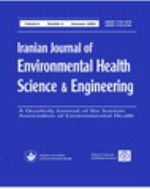
|
Iranian Journal of Environmental Health, Science and Engineering
Iranian Association of Environmental Health (IAEH)
ISSN: 1735-1979
Vol. 7, No. 1, 2010, pp. 43-52
|
 Bioline Code: se10005
Bioline Code: se10005
Full paper language: English
Document type: Research Article
Document available free of charge
|
|
|
Iranian Journal of Environmental Health, Science and Engineering, Vol. 7, No. 1, 2010, pp. 43-52
| en |
Urban Sprawl And Climatic Changes In Tehran
Roshan, Gh. R.; Shahraki, S. Zanganeh; Sauri, D. & Borna, R.
Abstract
Urban sprawl beginning in the developed countries around 1950 is currently experienced in almost all countries. Many studies on the effects of urban sprawl indicate the emergence of harmful effects of this phenomenon. One of the most important environmental effects is the changes in climate. The purpose of this research was to identify the relation between urban sprawl components of Tehran with changes in climate variables. To this end, two data sets have been used to study the relation between these elements and components. The first data set included climatic elements such as rainfall, temperature, the percent of relative humidity and the percent of calm wind, as well as its mean speed for a period of 54 years (1953-2006). The second set of data was formed by components relevant to urban sprawl such as city area, private cars per capita, population density and number of urban population. Pearson correlation and multiple regression methods have been applied to compare and identify the relation between climatic components with urban sprawl indices. Results of correlation indicate that among the 5 aforementioned climatic components, annual rainfall and the mean of wind speed do not appear to have significant relation with sprawl, but the oscillations in percent of relative humidity and percent of calm wind seem to have a significant relation with Tehran sprawl. Consequently and using multivariate regression, it was concluded that the most important factor in the increasing temperature of Tehran, is the number of cars; the most important factor in increasing the percent of relative humidity is the area of Tehran, whereas the increase of the percent of calm wind may be attributed to the increase of population.
Keywords
Urban Sprawl, Climate Change, Metropolis, Population Density, Tehran
|
| |
© Copyright 2010 - Tehran University of Medical Sciences Publications
Alternative site location: http://diglib.tums.ac.ir/pub/
|
|
